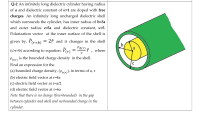Question
Thank you by now

Transcribed Image Text:Q-2 An infinitely long dielectric cylinder having radius
of a and dielectric constant of K=1 are doped with free
charges. An infinitely long uncharged dielectric shell
which surrounds the cylinder, has inner radius of b=3a
and outer radius c=5a and dielectric constant, K=5.
Polarization vector at the inner surface of the shell is
given by, P(r=b)
= 2î and it changes in the shell
(>r>b) according to equation: P(r)
mộ, where
a
r
Pb(r)
is the bounded charge density in the shell.
Find an expression for the
(a) bounded charge density, (p,o), in terms of a, r
(b) electric field vector at r=4a
(c) electric field vector at r=a/2
(d) electric field vector at r=6a
Note that there is no charge (free+bounded) in the gap
between cylinder and shell and no bounded charge in the
cylinder.
Expert Solution
This question has been solved!
Explore an expertly crafted, step-by-step solution for a thorough understanding of key concepts.
This is a popular solution
Trending nowThis is a popular solution!
Step by stepSolved in 9 steps with 10 images

Knowledge Booster
Similar questions
arrow_back_ios
SEE MORE QUESTIONS
arrow_forward_ios